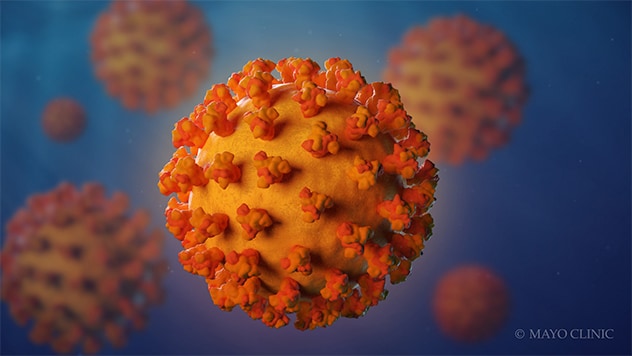Overview
Coronaviruses are a family of viruses that can cause illnesses such as the common cold, severe acute respiratory syndrome (SARS) and Middle East respiratory syndrome (MERS). In 2019, a new coronavirus was identified as the cause of a disease outbreak in China.
The virus is now known as the severe acute respiratory syndrome coronavirus 2 (SARS-CoV-2). The disease it causes is called coronavirus disease 2019 (COVID-19).
Cases of COVID-19 have been reported in a growing number of countries, including the U.S. Public health groups, such as the World Health Organization (WHO) and the U.S. Centers for Disease Control and Prevention (CDC), are monitoring the situation and posting updates on their websites. These groups have also issued recommendations for preventing and treating the illness.
Symptoms
Signs and symptoms of COVID-19 may appear two to 14 days after exposure and can include:
- Fever
- Cough
- Shortness of breath or difficulty breathing
The severity of COVID-19 symptoms can range from very mild to severe. People who are older or have existing medical conditions, such as heart disease, may be at higher risk of serious illness. This is similar to what is seen with other respiratory illnesses, such as influenza.
When to see a doctor
Contact your doctor right away if you have COVID-19symptoms and you've possibly been exposed to the virus. Tell your doctor if you've recently traveled internationally. Call your doctor ahead to tell him or her about your symptoms and recent travels and possible exposure before you go to your appointment.
Causes
It's unclear exactly how contagious the new coronavirus is. It appears to be spreading from person to person among those in close contact. It may be spread by respiratory droplets released when someone with the virus coughs or sneezes.
Risk factors
Risk factors for COVID-19 appear to include:
- Recent travel from or residence in an area with ongoing spread of COVID-19 as determined by CDC or WHO
- Close contact with someone who has COVID-19 — such as when a family member or health care worker takes care of an infected person
Prevention
Although there is no vaccine available to prevent infection with the new coronavirus, you can take steps to reduce your risk of infection. WHO and CDC recommend following the standard precautions for avoiding respiratory viruses:
- Wash your hands often with soap and water, or use an alcohol-based hand sanitizer.
- Cover your mouth and nose with your elbow or tissue when you cough or sneeze.
- Avoid touching your eyes, nose and mouth if your hands aren't clean.
- Avoid close contact with anyone who is sick.
- Avoid sharing dishes, glasses, bedding and other household items if you're sick.
- Clean and disinfect surfaces you often touch.
- Stay home from work, school and public areas if you're sick.
CDC doesn't recommend that healthy people wear a facemask to protect themselves from respiratory illnesses, including COVID-19. Only wear a mask if a health care provider tells you to do so.
WHO also recommends that you:
- Avoid eating raw or undercooked meat or animal organs.
- Avoid contact with live animals and surfaces they may have touched if you're visiting live markets in areas that have recently had new coronavirus cases.
Travel
If you're planning to travel internationally, first check the CDCand WHO websites for updates and advice. Also look for any health advisories that may be in place where you plan to travel. You may also want to talk with your doctor if you have health conditions that make you more susceptible to respiratory infections and complications



